
Show all 16 posts from this thread on one page
 |
Show all 16 posts from this thread on one page |
TurkoTek Discussion Forums
(http://www.turkotek.com/VB22/index.php)
- Mini-Salon 8:
Holiday Party at the Keshishian's. by R. John Howe
(http://www.turkotek.com/VB22/forumdisplay.php?forumid=60)
-- "Very unusual
Shirvan" (http://www.turkotek.com/VB22/showthread.php?threadid=1409)
"Very unusual Shirvan"
As far as the rugs are concerned this looks an interesting party - but where
are the ladies?
The motive on the "very unusual Shirvan rug" is the so
called 'kelleli' - it appears on Shirvan rugs from the Marasali area and on
Turkoman rugs according to Eder D (1990) Kaukasische Teppiche.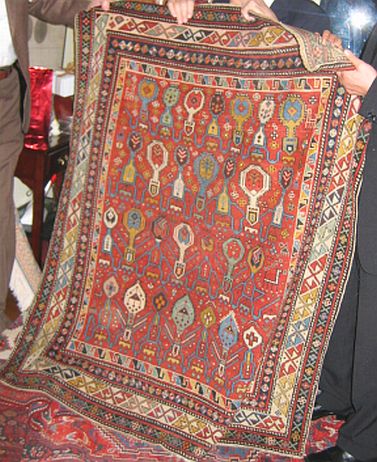
For L. Kerimov (Azadi
U, Kerimov L, Zollinger W (2001) Azerbaidjanisch-Kaukasische Teppiche) these
human figures are engaged in the Caucasian folk-dance 'jally'.
This rug
is particularly unusual in that the 'kelleli' makes up the whole of the field;
usually it is resricted to motive-bands in the upper and lower section of the
field.
Regards,
Horst
Hi Horst -
There were, in fact, quite a few ladies at this event and a
number of them are collectors.
As I said somewhere else, one of the
things one notices about rug collecting is that there is so much focus on the
items that one often almost doesn't notice the people. (Not entirely true of
events where collectors in fact go in part to see one another.)
I would
be interested to see instances of these field devices used in Turkmen rugs. Do
you know of any actual examples.
I was also hoping Austin Doyle whose
piece this is would chime in indicating what he knows about this design. I think
he said something about what he thinks is its likely
source.
Regards,
R. John Howe
John, a Happy New Year to you.
Unfortunately I can't recall where and
when I have seen the 'kelleli'-motiv on a Turkoman rug myself, most likely at
Lefevre's in London around twenty years ago or in some book. I have not looked
at many Turkoman rugs recently. Doris Eder on page 47 of the 1990 German edition
of her books says "Interessant ist ... der Vergleich mit dem turkmenischen
Kelleli-Motiv, wie es bei den Tekke zuweilen auf Taschen erscheint."
I
have a Turkish Kagizman Kelim on which the motiv makes a few random appearances,
not as a squadron as on the rug you presented us. I'll keep my eyes
open.
Regards,
Horst
Dear folks -
I have written to Austin Doyle, who owns the Shirvan that
begins this thread, asking him for some additional comment on it. He has
responded, with some additional images, giving me permission to quote
him.
Here are some additional images Austin sent of his Shirvan
piece.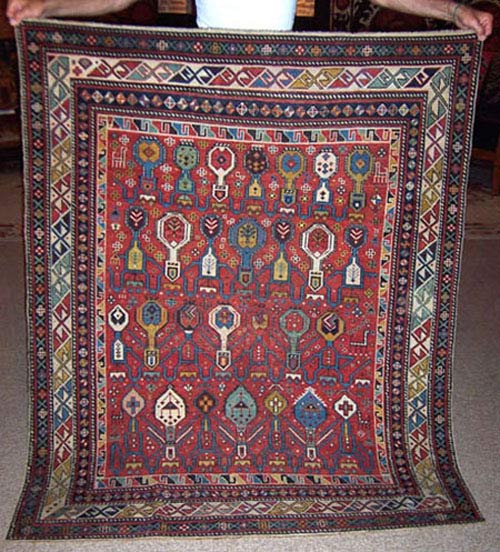
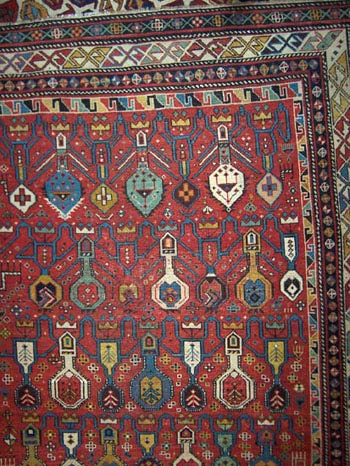
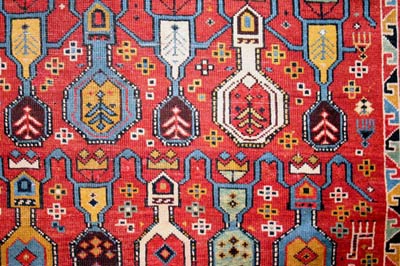
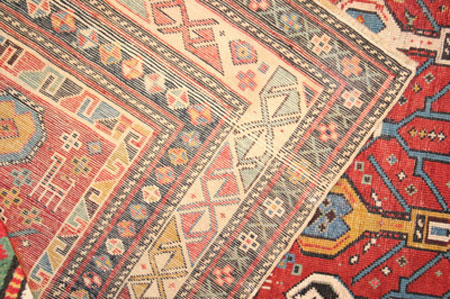
And here is his quoted comment:
"Dear John:
"I
got this rug from Davut Mizrahi, who acquired it from an Italian
estate.
Davut relates the rug to a group of squarish rugs of the first half of the 19th
century, often pictorial, from the Marasali area.
"This rug has a fine
weave, good wool, and no significant repairs. The rows of floral elements in the
field have a definite anthropomorphic feeling, and the comments of Mr. (ed.
Nitz) are of great interest.
"The inner border is interesting, and
Daniel Walker (ed. TM Director) related it to very old Turkish border designs.
"The rows of figures decrease in size going up the rug. I wondered
whether this might not be intentional, as in very old Turkoman bagfaces, to give
a sense of depth, with the upper rows of guls appearing to recede into the
field.
"The closest analogue that I could find to this rug was a
yellow-ground Shirvan rug sold at Rippon Boswell in 1998 (ed: see image below).
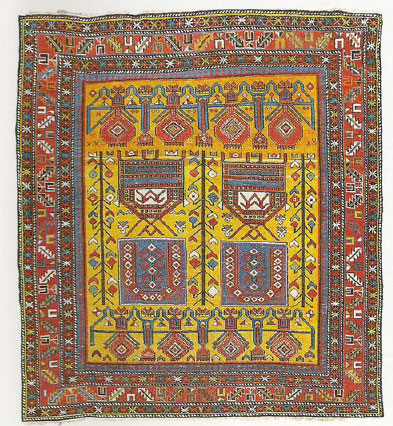
"As described by Horst (ed. Nitz), this rug has a row of
similar figures at one end of the field.
"I would appreciate it if you
could help me place (ed. these images) on the Turkotek site."
Thanks,
Austin.
Regards,
R. John Howe
Hello John, Austin,
I am tempted, but also very busy at the moment and
hesitate to enter into a deeper discussion of this rug. How about this if you
allow: I am preparing myself to host a salon in the second half of February,
hopefully, which would provide ample opportunity for a discussion of this rug in
context with others.
Regards,
Horst
Hi Horst -
We will gladly wait patiently.
Hard as it is to
conceive of, sometimes, there are parts of life outside rugs and Turkotek. 
Regards,
R.
John Howe
Dear all,
While we are waiting for Horst’s Salon, it doesn’t hurt to
proceed with further investigations about Mr. Doyle’s rug (any relation with the
other Doyle?)
John Howe signaled me that a somehow similar rug was on sale on
the web.
Here it is: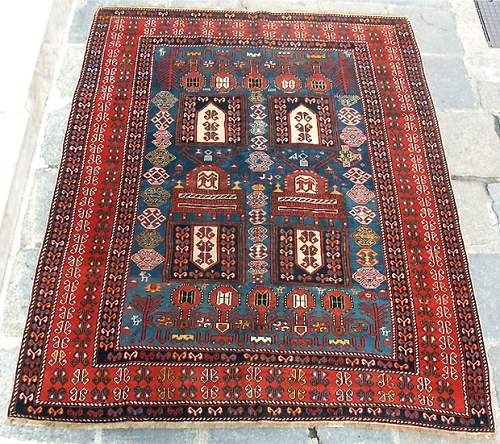
The seller labeled it
as a multiple saphs Shirvan, late 19th century.
This one rang a bell.
Of
course, Wright & Wertime “Caucasian Carpets and Covers” plate 30, page
82.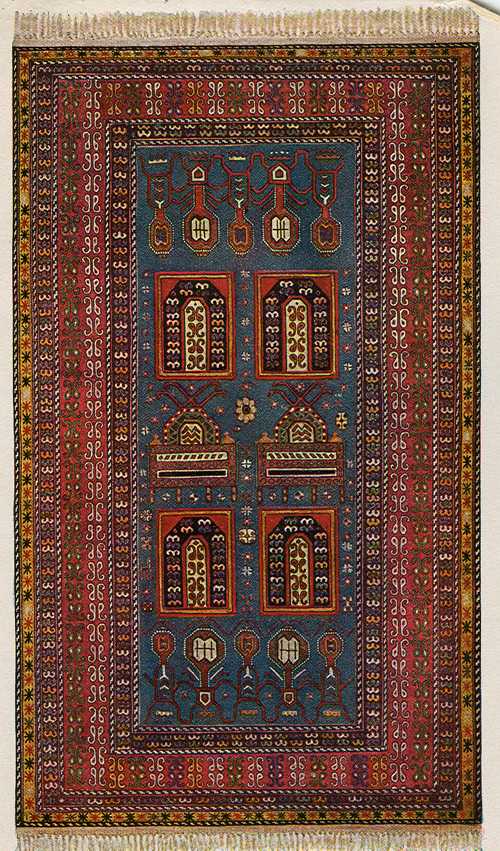
Shirvan pile rug, Shemakha district, Maraza village, “Gabistan”
pattern, Zakgorstorg lithograph, 1928.
The above image is not a scan from
the book but a resized version from Richard Wright’s website, more precisely
from the article on M. D. ISAEV which presents 21 more interesting
lithographs:
http://www.richardewright.com/0405_isaev.html
Also
Bennett’s “Caucasian” has more examples of this Shirvan multiple saphs genre,
which appears to be pretty “Kustar-ized”. This is plate 269 – with
caption: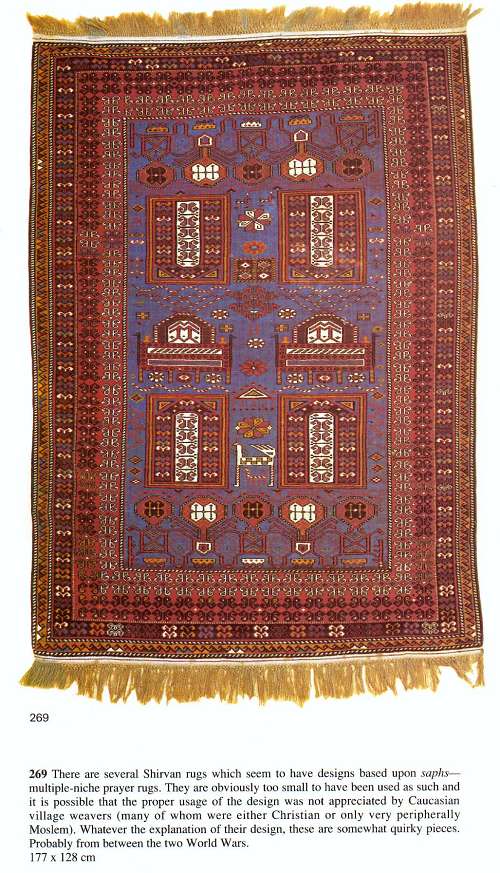
But this other one of plate 271 could be an earlier, no
“Kustar” example: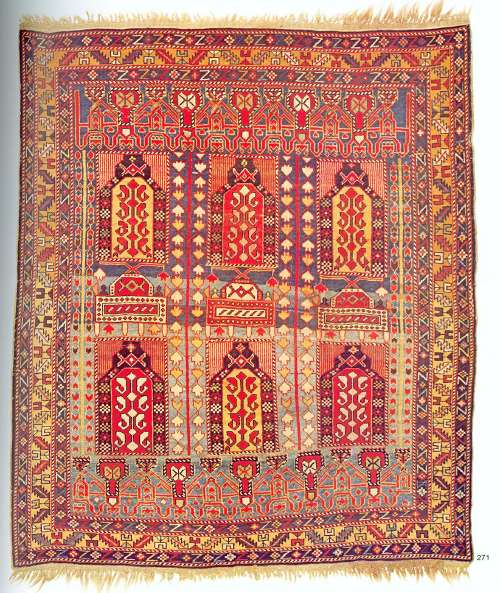
As for the unusual inner border of Mr. Doyle’s rug, there is
another example on a Shirvan rug from Bennett and Bassoul’s “Tapis du Caucase –
Rugs of the Caucasus”, Plate # 55.
Unfortunately I forgot to scan it. 
Best
regards,
Filiberto
Gabistan Mystery Revealed
Dear all,
So, here we have a rug with a “kelleli” motif
quote:
the so called 'kelleli' - it appears on Shirvan rugs from the Marasali area and on Turkoman rugs according to Eder D (1990) Kaukasische Teppiche. For L. Kerimov (Azadi U, Kerimov L, Zollinger W (2001) Azerbaidjanisch-Kaukasische Teppiche) these human figures are engaged in the Caucasian folk-dance 'jally'.
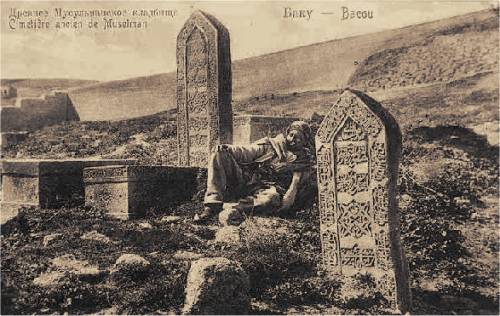
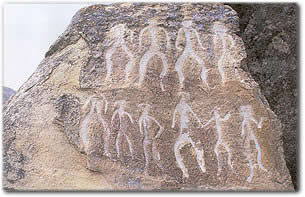
Dear Filiberto,
I think you did a great job.
A rug salesman
couldn't have done it better
What I think? Only a tiny remark. I would love to hear the
music but I'm not sure about the Stone Age Rock engravings dancing. Are they?
Did they sing? Played instruments?
Stone Age Rock? Isn't this what we
hear everyday. Wow, that's another link.
Rock around the clock and wave
around the cave. Ah, so what we see is the first human wave. If it is a wave
there must have been something to wave for.......
Thank you
again,
best regards,
Vincent
Thank you Vincent,
About the music, the Gobustan site mentions the use
of a “so called "gaval dash" (tambourine stone), which emits a booming sound
when it is struck, was probably used for accompaniment to the yalla
dance.”.
So, it was a real Rock music. 
But I’m not finished with my
research, yet.
This is another rug with multiple saphs design. It’s for
sale, so better refraining from comments on it.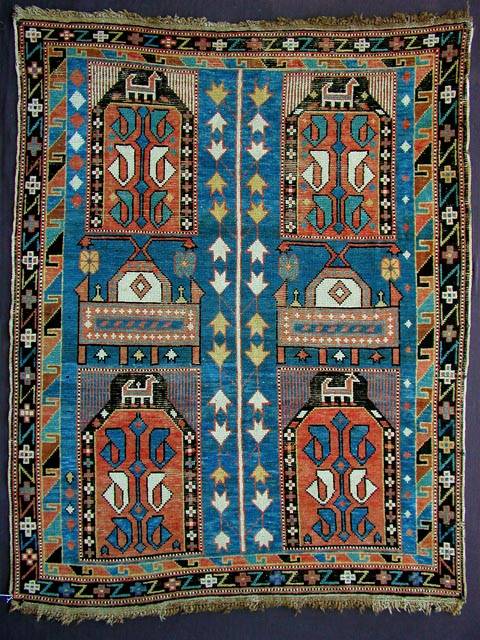
The seller attributes
it as Kuba Avar, third quarter of 19th century. Cotton wefts and camel
warps.
The seller indicates also the possibility that the saphs could be
tombstones, on which I agree.
This rug is more similar to my last scan
from Bennett’s, but it lacks the “kelleli” - or “yalla dance” – motif. It has
the same unusual inner border of Mr. Doyle’s, though. The outer border is also
almost identical.
Regards,
Filiberto
Rock music....
Hi all,
The "tambourine stone" mentioned in Filiberto's post reminds
me of the c. 16th century Vittal "Musical" Temple in ruins of Hampi (Bellary
District, Karnataka, India). There are dozens of stone pillars that have been
carved such that their dimensions and the tension on them create different
musical notes. One set creates a perfect "eastern" musical scale. It is said
that during nights of revelry the pillars were played by musicians with wooden
and ivory sticks while temple dancers performed. The music could be heard from
kilometres away.
James.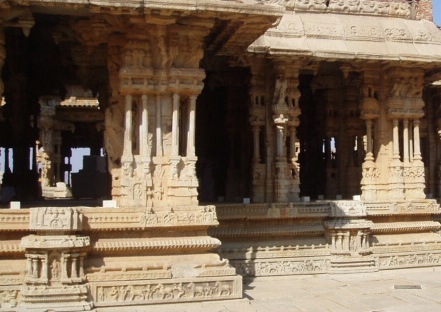
Dear folks -
The energy and imagination being displayed in this thread
lures me to ask whether it is possible that the pieces with four panels somewhat
like those on many doors might be atavistic decendents of Caucasian
"engsis?"
Nah. 
Regards,
R. John Howe
The rug Mr. R. John found looks like an Ashaga Fyndygan Baku. Wright and Wertime say Maraza but in the time frame that their information comes from Maraza was the Administrative center for a broad area including Ashaga Fyndygan. I am surprised my other post was not printed. If I said it was Mongol you print but if I give a specific place attribution you print not.
Hi Ashok
Several of your posts were blocked by me and Filiberto
because they included smartass remarks, some overt, some a little more subtle,
about other people. We'll post anything civil, especially if it's informative.
If you want to post remarks about others, I'll be happy to e-mail you a URL that
will accept and encourage them.
Steve Price
Dear folks -
Since we are already speculating a bit here, let me add
one more probably unlikely similarity I have encountered in the last day or
two.
In exploring a question about Persepolis, I had occasion to look
again at Tanavoli's book on Persian pictorial rugs and to those that seem to
have reference to Persepolis in particular.
Austin said early that the
devices in the fields these Caucasian rugs seem to have an anthropmorphic
flavor. The rugs with Persepolis references often have rows (usually at the
bottom) of human figures with their arms raised as if holding a horizontal piece
above them.
Although most rugs with Persepolis references seem to had
been made in SW Persia (Tanavoli shows one that he says is Hammadan) it would
not take much abstraction for these figures with upraised arms to begin to
resemble the seeming anthropmorphic forms in these Caucasian rugs.
There
were Caucasians who were transplanted to SW Persia but I'm not sure that the
reverse occurred. Anyway, this similarity is my probably groundless speculation
of the day.
Regards,
R. John Howe
Hi John,
Do you mean something like this? (following are two scan from
Opie’s “Tribal Rugs” page 189 and 188):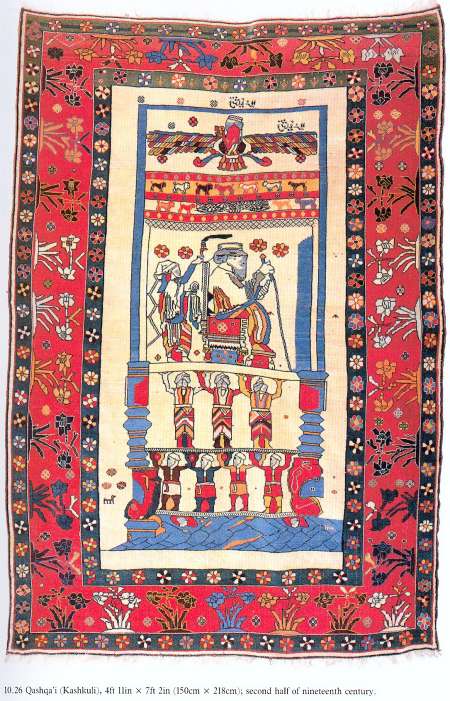

If so, the images are
self-explaining, no Caucasian connection.
But it’s better to put this
thread at rest; otherwise we are in danger of compromising Horst’s upcoming
Salon.
Regards,
Filiberto
| All times are GMT -5 hours. The time now is 09:40 AM. | Show all 16 posts from this thread on one page |
Powered
by: vBulletin Version 2.2.6
Copyright © Jelsoft Enterprises Limited 2000,
2001.